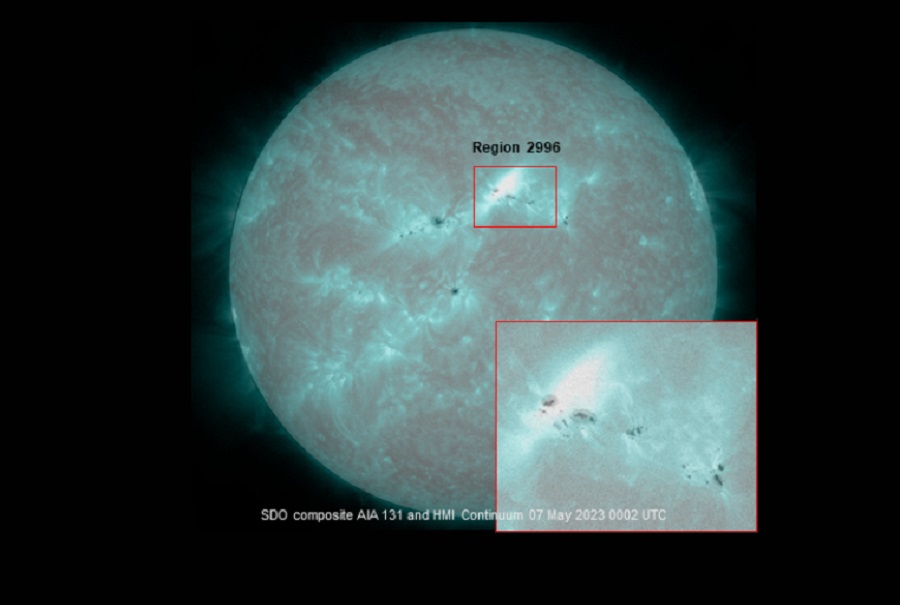
The Sun exploded to life late yesterday, with a solar blast expected to impact Earth as soon as tomorrow. Ahead of the impacts to Earth, the National Weather Service’s Space Weather Prediction Center (SWPC) has issued Geomagnetic Storm Watches for Wednesday and Thursday with multiple impacts expected, including the likely display of vivid aurora in places that don’t always see the Northern Lights. Additional blasts of energy from the storm have also been released, which could enhance impacts to Earth over the next several days.
According to the SWPC, a solar flare from Sunspot Region 2996 on May 7 was associated with a partial halo Coronal Mass Ejection (CME) and added that an Earth-directed CME is probable with a shock arrival expected on Wednesday. Should the CME arrive as forecast, a Moderate G2 level geomagnetic storm is likely on May 10 followed by minor G1 level geomagnetic storm conditions on May 11. Due to that forecast, the SWPC has issued a Geomagnetic Storm Watch for both May 10 and May 11.
The SWPC says the forecast and intensity of this ongoing active solar storm activity could change. “Dependent upon the CME trajectory, there is a slight, and decreasing chance of G3 (Strong) levels associated with the CME effects. G1 (Minor) storms are currently anticipated on 11 May as CME influences continue; however, based on our analysis of the most recent M4 flare associated CME – this forecast may be upgraded,” the SWPC wrote in an updated Forecast Discussion this evening. “Currently, we anticipate active conditions on May 12, but any CME influences from the most recent CME could continue and these levels may be upgraded accordingly as well.”
Coronal Mass Ejections (CMEs) are large expulsions of plasma and magnetic field from the Sun’s corona. They can eject billions of tons of coronal material and carry an embedded magnetic field, frozen in flux, that is stronger than the background solar wind interplanetary magnetic field (IMF) strength. CMEs travel outward from the Sun at various speeds, with some reaching the Earth as quickly as 15-18 hours and others requiring days to arrive. According to the SWPC, CMEs expand in size as they propagate away from the Sun and larger ones can reach a size comprising nearly a quarter of the space between Earth and the Sun by the time it reaches our planet.
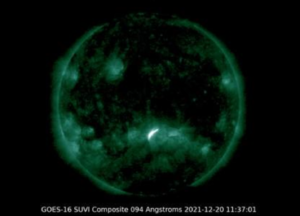
As the CME interacts with Earth and its magnetosphere, a variety of things could unfold based on the amount of energy hitting and the angle it impacts the Earth.
Geomagnetic storms are rated on a 1-5 scale by the SWPC, with 1 considered minor and 5 considered extreme. Geomagnetic storms can disrupt electronics and electrical systems, interfere with spacecraft and satellite communication, and also trigger brilliant displays of the aurora in the night sky.
In the case of the solar storm due to impact Earth in the coming hours and days, weak power grid fluctuations could occur, especially at northern latitudes. Minor impacts on satellite operations could also be possible. Aurora could also be visible more south than it usually is; in this case, it could extend as far south as New York and Idaho. Should the geomagnetic storm become stronger, aurora could be brighter and could appear even more south.
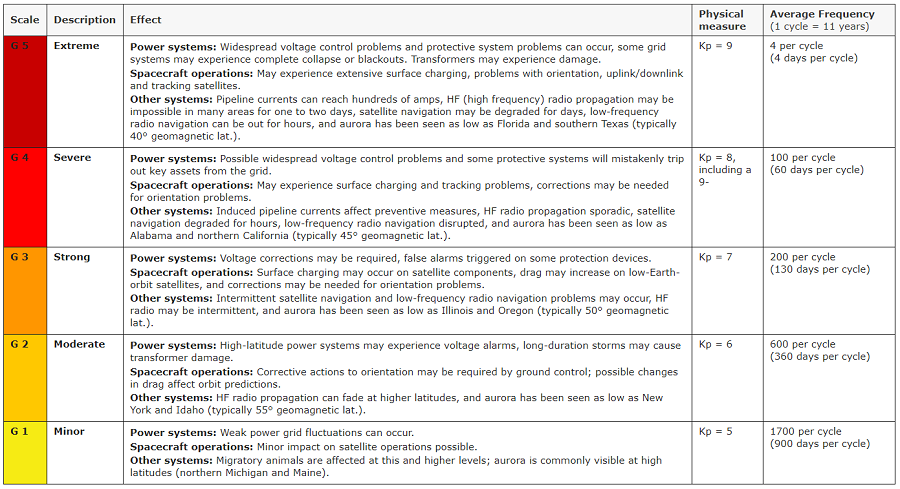
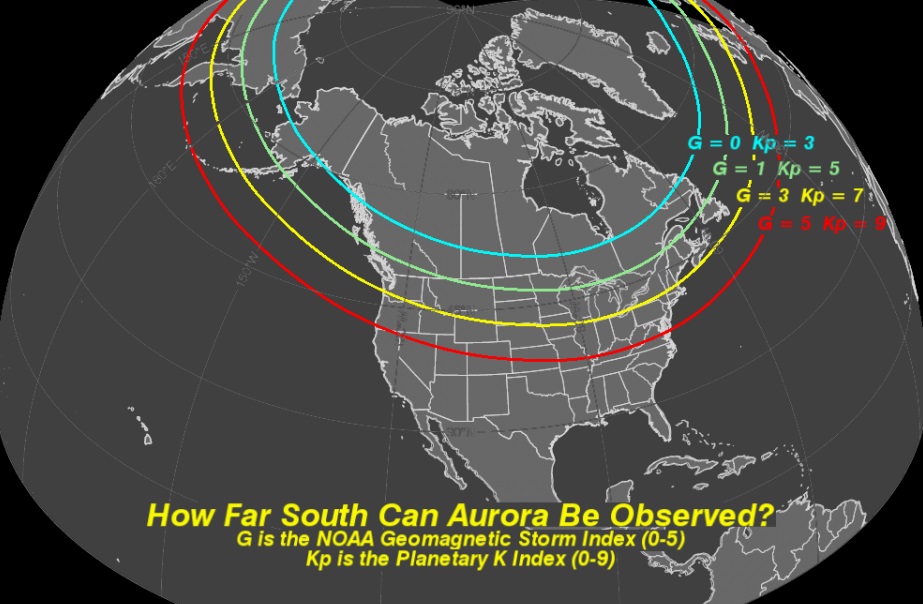
One frequent side effect of these geomagnetic storms is the presence of aurora. The probability and location of aurora displays is based on the Kp index of the storm. The K-index, and by extension the Planetary K-index, are used to characterize the magnitude of geomagnetic storms. The SWPC says that Kp is an excellent indicator of disturbances in the Earth’s magnetic field and is used by SWPC to decide whether geomagnetic alerts and warnings need to be issued for users who are affected by these disturbances. Beyond signifying how bad a geomagnetic storm’s impact can be felt, the Kp index can also help indicate how low, latitude-wise the aurora will be.
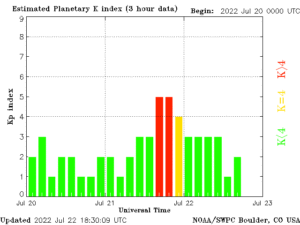
The initial NOAA Space Weather Prediction Center (SWPC) called for the ongoing geomagnetic storm, prior to today’s fresh blasts, to have a Kp index of 6 or greater. The greater the number, the more vibrant aurora can be; in the Northern Hemisphere, a higher Kp index also means the aurora could establish itself high above the United States in southern locations that don’t ordinarily see the Northern Lights. Should the Kp index become greater than the 6that was initially forecast, aurora currently predicted to be visible in places like northern Michigan or Maine could travel south: a KP index of 7 or more could make the aurora present in clear skies in Boston, Chicago, and Seattle; a Kp index of 9 or more could illuminate the clear night skies of Washington, DC, Saint Louis, Denver, and even Salt Lake City. In past severe geomagnetic storms, the aurora has been visible as far south as Hawaii and the central Caribbean.
The latest geomagnetic forecast from the SWPC is calling for a maximum Kp index of 6 during the night of May 10. If that were to materialize, the aurora could be visible in clouds free of light and cloud pollution across the Great Lakes, central New England, the Upper Midwest, and much of Montana and Washington. If the Kp doesn’t reach that intensity, visible aurora could be confined to Canada. If the opposite happens and the Kp surges above forecast level to 7, 8, or even 9, major cities in the Mid Atlantic, across the midwest, and throughout the Pacific Northwest could see the aurora if sky conditions cooperated.
While a higher Kp Index generally produces a more spectacular aurora display, it also presents more of a danger to systems that could be impacted by geomagnetic disturbances. Electrical system failures, grid failures, communication and navigation system faults, and more could happen if the geomagnetic storm is powerful enough.
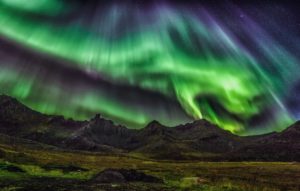
NOAA forecasters analyze a variety of solar data from spacecraft to determine what impacts a geomagnetic storm could produce. Analyzing data from the DSCOVER and ACE satellite is one way forecasters can tell when the enhanced solar wind from a coronal hole is about to arrive at Earth. A few things they look for in the data to determine when the enhanced solar wind is arriving at Earth:
• Solar wind speed increases
• Temperature increases
• Particle density decreases
• Interplanetary magnetic field (IMF) strength increases
While these solar events can help illuminate the sky with stunning aurora, they can also do considerable harm to electronics, electrical grids, and satellite and radio communications.
The 1859 incident, which occurred on September 1-2 in 1859, is also known as the “Carrington Event.” This event unfolded as powerful geomagnetic storm struck Earth during Solar Cycle 10. A CME hit the Earth and induced the largest geomagnetic storm on record. The storm was so intense it created extremely bright, vivid aurora throughout the planet: people in California thought the sun rose early, people in the northeastern U.S. could read a newspaper at night from the aurora’s bright light, and people as far south as Hawaii and south-central Mexico could see the aurora in the sky.
The event severely damaged the limited electrical and communication lines that existed at that time; telegraph systems around the world failed, with some telegraph operators reporting they received electric shocks.
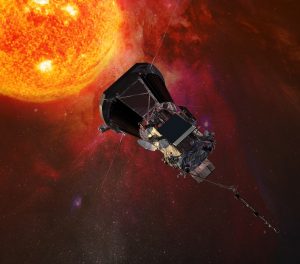
A June 2013 study by Lloyd’s of London and Atmospheric and Environmental Research (AER) in the U.S. showed that if the Carrington event happened in modern times, damages in the U.S. could exceed $2.6 trillion, roughly 15% of the nation’s annual GDP.
While typically known for their weather forecasts, the National Oceanic and Atmospheric Administration (NOAA) and its National Weather Service (NWS) is also responsible for “space weather.” While there are private companies and other agencies that monitor and forecast space weather, the official source for alerts and warnings of the space environment is the Space Weather Prediction Center (SWPC). The SWPC is located in Boulder, Colorado and is a service center of the NWS, which is part of NOAA. The Space Weather Prediction Center is also one of nine National Centers for Environmental Prediction (NCEP) as they monitor current space weather activity 24/7, 365 days a year.